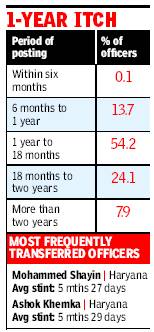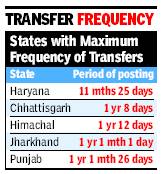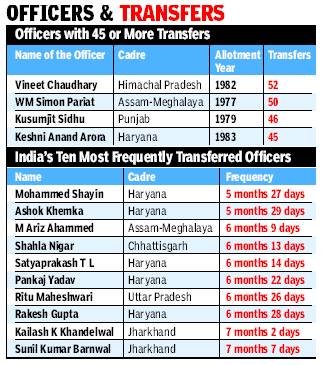Indian Administrative Service (IAS)
(→The Indian Administrative Service (IAS)) |
|||
| Line 44: | Line 44: | ||
Officer can be suspended for one year maximum, pending inquiry | Officer can be suspended for one year maximum, pending inquiry | ||
| + | |||
| + | =Frequency of transfers= | ||
| + | [[File: IASa.jpg||frame|500px]] | ||
| + | [[File: IASb.jpg||frame|500px]] | ||
| + | [[File: IASc.jpg||frame|500px]] | ||
| + | |||
| + | ''' 68% IAS officers have avg stints of 18 mths or less ''' | ||
| + | |||
| + | ''' Most Transferred Civil servant Shifted 52 Times In 31 Years ''' | ||
| + | |||
| + | Atul Thakur TIG | ||
| + | |||
| + | [http://epaper.timesofindia.com/Default/Scripting/ArticleWin.asp?From=Archive&Source=Page&Skin=TOINEW&BaseHref=CAP/2014/01/01&PageLabel=3&EntityId=Ar00301&ViewMode=HTML The Times of India ] | ||
| + | ==1976-2003 batches: Average tenures of 18 months or less == | ||
| + | Ashok Khemka has become famous as a much-transferred IAS officer, but he is far from being the only one to have been shunted ever so often. An analysis of the executive record (ER) sheets of thousands of IAS officers currently in service reveals that frequent transfers are depressingly common. | ||
| + | |||
| + | It shows that 68% (over two-thirds of the officers have had average tenures of 18 months or less. The analysis | ||
| + | used ER sheets of all 2,139 officers now in service who were selected through the UPSC’s civil services exam and had completed 10 years or more of service on November 13, 2013, the date on which this analysis was undertaken. | ||
| + | |||
| + | Among these officers, Vineet Chaudhary, a 1982 batch Himachal Pradesh cadre officer, has been transferred 52 times, the highest in the country. Similarly, Assam-Meghalaya cadre officer Winston Mark Simon Pariat has been transferred 50 times in his 36-year career. Kusumjit Sidhu of the Punjab cadre witnessed 46 transfers in a career which spanned over three decades and like his famous colleague Khemka, Haryana cadre officer Keshni Anand Arora is also serving her 45th posting. | ||
| + | |||
| + | There are 13 officers who have undergone 40 or more transfers in their career. Interestingly, seven of these are from the Haryana cadre alone. Himachal and Jharkhand have two such officers each while Assam-Meghalaya and Uttar Pradesh account for one IAS officer each with 40 or more transfers. | ||
| + | |||
| + | The number of transfers alone doesn’t explain the difficulties of the prestigious job. It is the frequency which is more alarming. On this count too, Haryana emerges as the worst state for an IAS officer to be posted in. Five of the country’s 10 most frequently transferred officers are from Haryana; two from Jharkhand and one each from Chhattisgarh, UP and Assam-Meghalaya. | ||
| + | ==Shayin, Khemka most transferred civil servants | ||
| + | Mohammed Shayin and Khemka — both Haryana cadre — are India’s most frequently transferred IAS officers, their average frequency being more than once in six months. Similarly, the average time spent between two postings for M Ariz Ahammed, Shahla Nigar, Satyaprakash TL, Pankaj Yadav, Ritu Maheshwari and Rakesh Gupta has been less than seven months. Kailash Kumar Khandelwal and Sunil Kumar Barnwal, who also make it to the list of the country’s 10 most frequently transferred officers, have been transferred within seven months and seven days of posting, on an average. | ||
| + | |||
| + | TOI’s analysis suggests that roughly 14% officers get transferred within one year of service and another 54% within 18 months. In other words, 68%, or over two-thirds of India’s top bureaucrats, last on an average less than 18 months at a posting. Only 8% of the officers analyzed had average tenures of more than two years and there are only 14 officers who have managed to complete an average stay of more than three years between transfers. | ||
| + | |||
| + | So how do the frequent transfers impact bureaucracy, the officials and the general public? “Frequent transfers impact the working of the system and demoralize the bureaucracy,” says Bhoosreddy. honorary secretary of the Central IAS association, “The family of the officer is the worst sufferer. It affects children’s education and in many cases increases the financial burden as the transfers often cause job loss of the officer’s spouse”, he adds. He further argues that the poor and the vulnerable section is the worst hit as transfers severely impact welfare schemes. “Above all, the common man has to bear the burden of the additional administrative cost of transfer allowance,” he says. | ||
| + | |||
| + | The 15th report of the Second Administrative Reforms Commission stated that appointments at the highest level of administration often lack transparency and objectivity. The report observed that transfers often coincide with a change in political regime. This leads to instability of administration and lack of faith in the system among the common people. | ||
| + | |||
| + | News reports have also repeatedly confirmed politically motivated transfers and today it is not unusual for ordinary people to associate a particular official with a politician or party. “Transfers with change in political executive are a reality after 1970s and this tendency is raising the question of neutrality of the bureaucracy”, adds Bhoosreddy. Other sources, on condition of anonymity, told TOI that many times during a political vacuum between regimes, honest bureaucrats in senior positions get the chance to issue marching orders to corrupt subordinates. | ||
| + | == State-wise analysis== | ||
| + | A state-wise analysis of the frequency of IAS transfers once again shows that Haryana is the worst to work in. On an average, an IAS officer is transferred in 11 months and 25 days in the state. Chhattisgarh, Himachal Pradesh, Jharkhand and Punjab are other states that show up badly on this parameter. A bird’seye view of state-wise transfer data suggests that states which are perceived as badly governed tend to be the ones where IAS transfers are more frequent. | ||
Revision as of 13:54, 1 January 2014
This is a collection of articles archived for the excellence of their content. Readers will be able to edit existing articles and post new articles directly |
Contents |
The Indian Administrative Service (IAS)
SUSPENSION RULES FOR IAS
State can keep IAS officer under suspension, pending disciplinary action
Suspension to continue only if Centre (DoPT) confirms it
State can’t delay report beyond maximum 90 days without Centre’s confirmation
For disciplinary proceedings, IAS officer presents reply to chief secretary
The chief secretary, a state’s top bureaucrat, can take a call to either continue suspension or revoke it based on report
State must then send report to Centre for confirmation
Opinion of Centre prevails
If Centre goes by state’s report, suspended officer can move court — Central Administrative Tribunal (CAT)
CAT acts as arbiter. Takes into account Centre’s and state’s recommendations and officer’s version
CAT judges if state followed due procedure as per service rules in suspending officer
During this period, officer in question receives half pay & housing facility
Period of suspension on charges other than corruption can’t exceed a year, pending further inquiry
If inquiry not completed within a year, suspension order stands revoked
Officer can be suspended for one year maximum, pending inquiry
Frequency of transfers
68% IAS officers have avg stints of 18 mths or less
Most Transferred Civil servant Shifted 52 Times In 31 Years
Atul Thakur TIG
1976-2003 batches: Average tenures of 18 months or less
Ashok Khemka has become famous as a much-transferred IAS officer, but he is far from being the only one to have been shunted ever so often. An analysis of the executive record (ER) sheets of thousands of IAS officers currently in service reveals that frequent transfers are depressingly common.
It shows that 68% (over two-thirds of the officers have had average tenures of 18 months or less. The analysis used ER sheets of all 2,139 officers now in service who were selected through the UPSC’s civil services exam and had completed 10 years or more of service on November 13, 2013, the date on which this analysis was undertaken.
Among these officers, Vineet Chaudhary, a 1982 batch Himachal Pradesh cadre officer, has been transferred 52 times, the highest in the country. Similarly, Assam-Meghalaya cadre officer Winston Mark Simon Pariat has been transferred 50 times in his 36-year career. Kusumjit Sidhu of the Punjab cadre witnessed 46 transfers in a career which spanned over three decades and like his famous colleague Khemka, Haryana cadre officer Keshni Anand Arora is also serving her 45th posting.
There are 13 officers who have undergone 40 or more transfers in their career. Interestingly, seven of these are from the Haryana cadre alone. Himachal and Jharkhand have two such officers each while Assam-Meghalaya and Uttar Pradesh account for one IAS officer each with 40 or more transfers.
The number of transfers alone doesn’t explain the difficulties of the prestigious job. It is the frequency which is more alarming. On this count too, Haryana emerges as the worst state for an IAS officer to be posted in. Five of the country’s 10 most frequently transferred officers are from Haryana; two from Jharkhand and one each from Chhattisgarh, UP and Assam-Meghalaya. ==Shayin, Khemka most transferred civil servants Mohammed Shayin and Khemka — both Haryana cadre — are India’s most frequently transferred IAS officers, their average frequency being more than once in six months. Similarly, the average time spent between two postings for M Ariz Ahammed, Shahla Nigar, Satyaprakash TL, Pankaj Yadav, Ritu Maheshwari and Rakesh Gupta has been less than seven months. Kailash Kumar Khandelwal and Sunil Kumar Barnwal, who also make it to the list of the country’s 10 most frequently transferred officers, have been transferred within seven months and seven days of posting, on an average.
TOI’s analysis suggests that roughly 14% officers get transferred within one year of service and another 54% within 18 months. In other words, 68%, or over two-thirds of India’s top bureaucrats, last on an average less than 18 months at a posting. Only 8% of the officers analyzed had average tenures of more than two years and there are only 14 officers who have managed to complete an average stay of more than three years between transfers.
So how do the frequent transfers impact bureaucracy, the officials and the general public? “Frequent transfers impact the working of the system and demoralize the bureaucracy,” says Bhoosreddy. honorary secretary of the Central IAS association, “The family of the officer is the worst sufferer. It affects children’s education and in many cases increases the financial burden as the transfers often cause job loss of the officer’s spouse”, he adds. He further argues that the poor and the vulnerable section is the worst hit as transfers severely impact welfare schemes. “Above all, the common man has to bear the burden of the additional administrative cost of transfer allowance,” he says.
The 15th report of the Second Administrative Reforms Commission stated that appointments at the highest level of administration often lack transparency and objectivity. The report observed that transfers often coincide with a change in political regime. This leads to instability of administration and lack of faith in the system among the common people.
News reports have also repeatedly confirmed politically motivated transfers and today it is not unusual for ordinary people to associate a particular official with a politician or party. “Transfers with change in political executive are a reality after 1970s and this tendency is raising the question of neutrality of the bureaucracy”, adds Bhoosreddy. Other sources, on condition of anonymity, told TOI that many times during a political vacuum between regimes, honest bureaucrats in senior positions get the chance to issue marching orders to corrupt subordinates.
State-wise analysis
A state-wise analysis of the frequency of IAS transfers once again shows that Haryana is the worst to work in. On an average, an IAS officer is transferred in 11 months and 25 days in the state. Chhattisgarh, Himachal Pradesh, Jharkhand and Punjab are other states that show up badly on this parameter. A bird’seye view of state-wise transfer data suggests that states which are perceived as badly governed tend to be the ones where IAS transfers are more frequent.


